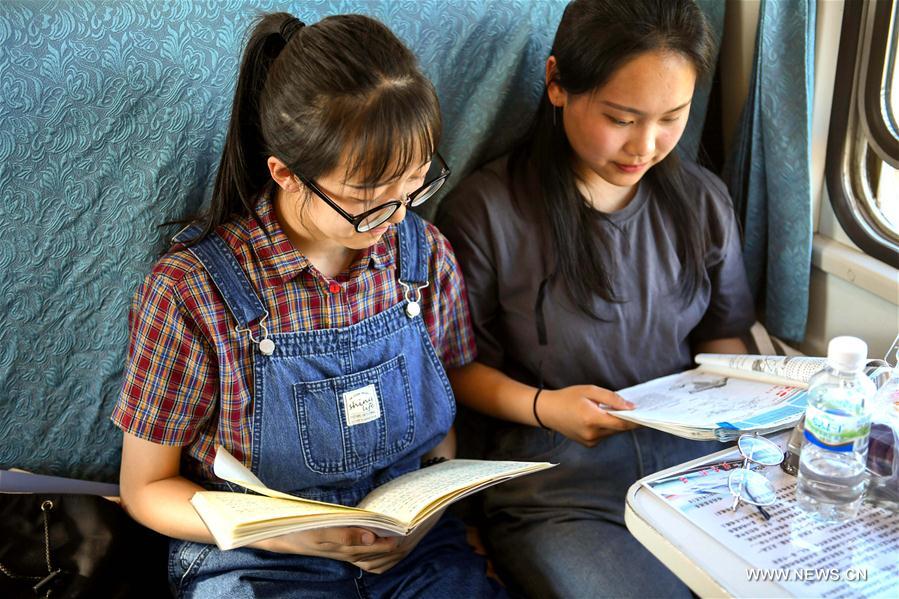


Candidates of the national college entrance exam review lessons on a special train which will take them to exam site in Alihe Township from Dayangshu Township of Oroqen Autonomous Banner, north China's Inner Mongolia Autonomous Region, June 5, 2017. Over 600 students took the special train to attend this year's national college entrance examination, known as the Gaokao, due to kick off on June 7. (Xinhua/Wang Song)
BEIJING, June 6 (Xinhua) -- When China's national college entrance exam, gaokao, resumed in 1977, Huang Liang, breadwinner of his family, quit his job.
He was in his dormitory in a factory in southwest China's Chongqing when he heard the news through a loudspeaker.
The 32-year-old father took the exam in the bitter winter of that year and was admitted to Chongqing Normal University, one of 273,000 lucky people to get letters of college acceptance. With 5.7 million sitting the exam that year, the enrollment rate was less than 5 percent.
For the past 40 years, the exam has been decisive in determining who would find a well-paid job and successful career.
Gaokao was disrupted by the Cultural Revolution (1966-76) and its reintroduction by then leader Deng Xiaoping was a clear signal that times had changed. For over 40 years, the fierce but fair competition has been almost the only way for students from poor, rural areas to change their lives.
On Wednesday, 9.4 million students will take the world's largest exam in pursuit of their own dreams and join the drive for national rejuvenation, the Chinese Dream.
The restoration of gaokao changed the lives of tens of millions of people like Huang. And the country soon began reform and opening-up, which led directly to decades of growth.
From 1977 to 2016, 120 million Chinese enrolled in universities. "The average number of years in education for our labor force increased from 5.7 to 11.9," said Dai Jiagan, deputy director of the Chinese Society of Education.
"Without gaokao, we could not have reached our current phase of development. The fate of gaokao has been closely related to that of the country and the people."
In the first three years after the restoration of gaokao, more than 900,000 university students became backbone professionals in different walks of life in the country.
"This group of people were a key driving force in reform and opening-up," said Liu Haifeng, head of the school of education at Xiamen University in east China's Fujian Province.
"Despite its weak points such as the heavy burden on students, gaokao is a test that fits China's overall conditions and is a fair start for all."
"The successes of the past 30-odd years have a lot to do with the gaokao system," Liu added.
Cheng Fangping, a professor in history of education at Renmin University of China, agrees. He regards the normalization of China's higher education system as epoch-making, with an inspirational impact on reform, culture, science, thinking and law.
The building of discipline, the fostering of talent and the vision that has driven economic development, were all strengthened through gaokao, said Cheng.
Cooperation between colleges and industry and the emergence of university-centered development zones have all played their parts in the country's economic rise.
From 2011 to 2015, universities churned out nearly 20 million professionals, firing up high-tech and emerging industries. Vocational schools send nearly 10 million technical graduates out into the job market each year.
China has almost 3,000 higher-learning institutions. Of 9.4 million Chinese who sit the exam on Wednesday, around 4 million of them will be given the chance to continue their education. By 2020, 50 percent of gaokao entrants will find places at college.
Special dispensation is now guaranteed for under-privileged students and those with special needs, including those with disabilities. The system now better serves innovation-driven development and encourages creativity.
The exam, however, is not without its critics, mostly for overemphasis on grades and students being obliged to choose between science and liberal arts at an early stage.
China plans to overhaul its college entrance exam and university enrollment system by 2020, to improve fairness and transparency. In east China's Shanghai and Zhejiang Province, pilot reforms are under way in this regard.
Students from central and western parts of the country are now guaranteed more places in college, and there is a push to enroll more students from rural areas.
Gaokao continues to play its key role in enabling the nation to eradicate poverty by 2020 and pursue sustainable growth driven by innovation and consumption.
Sun Pishu, chairman of China's cloud computing and big data provider Inspur Group, went to university in 1978. After graduation, he worked in an electronics plant, the predecessor of Inspur. Ten years later, he developed the country's first small server. Currently, Inspur, based in east China's Shandong Province, supplies IT products and services for 108 countries and regions
"I was part of the second batch of students after the gaokao resumption. I was driven to serve the country and full of energy," said Sun.

 Award-winning photos show poverty reduction achievements in NE China's Jilin province
Award-winning photos show poverty reduction achievements in NE China's Jilin province People dance to greet advent of New Year in Ameiqituo Town, Guizhou
People dance to greet advent of New Year in Ameiqituo Town, Guizhou Fire brigade in Shanghai holds group wedding
Fire brigade in Shanghai holds group wedding Tourists enjoy ice sculptures in Datan Town, north China
Tourists enjoy ice sculptures in Datan Town, north China Sunset scenery of Dayan Pagoda in Xi'an
Sunset scenery of Dayan Pagoda in Xi'an Tourists have fun at scenic spot in Nanlong Town, NW China
Tourists have fun at scenic spot in Nanlong Town, NW China Harbin attracts tourists by making best use of ice in winter
Harbin attracts tourists by making best use of ice in winter In pics: FIS Alpine Ski Women's World Cup Slalom
In pics: FIS Alpine Ski Women's World Cup Slalom Black-necked cranes rest at reservoir in Lhunzhub County, Lhasa
Black-necked cranes rest at reservoir in Lhunzhub County, Lhasa China's FAST telescope will be available to foreign scientists in April
China's FAST telescope will be available to foreign scientists in April